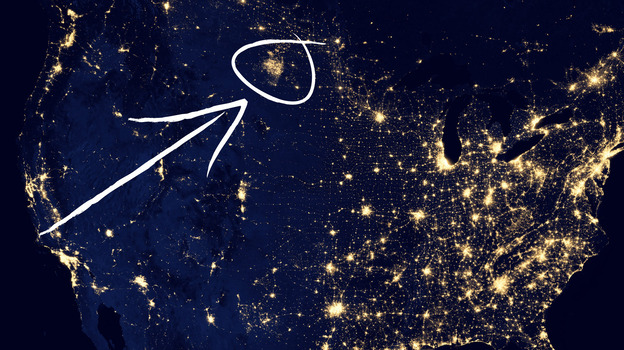New satellite technology has yielded a stunning new set of views of the Earth at night. And a surprise — in North Dakota, near the Canadian border, there is a bright spot. It’s not a city. It wasn’t there six years ago. It, too, is new. You’ll see it in the video below as the US comes into view.
Recently, NPR explained the source of this mysterious and large cluster of lights on the otherwise empty prairies of North Dakota — new oil fields created by fracking technologies. As Robert Krulwich writes:
This oil rush is so sudden, so enormous, North Dakota now has the lowest unemployment rate in the country. More than 41,000 workers got jobs there between 2008 and 2012. Only seven years ago, the U.S. was importing 60 percent of its oil. Now imports are down to 42 percent.
The wells are here:
 Some of the lights are from drilling pads and platforms, but the majority of the light comes from natural gas being vented and flared off as a byproduct of the oil extraction process. According to one source, drillers “burn off enough gas to heat half a million homes.” Or, as Krulwich writes:
Some of the lights are from drilling pads and platforms, but the majority of the light comes from natural gas being vented and flared off as a byproduct of the oil extraction process. According to one source, drillers “burn off enough gas to heat half a million homes.” Or, as Krulwich writes:
There are now so many gas wells burning fires in the North Dakota night, the fracking fields can be seen from deep space.
Happy Fracking Friday!
Discussion
9 Thoughts on "The Earth at Night — And a Mysterious Patch of Light Appears Suddenly in North Dakota"
Reblogged this on Simon Hamer and commented:
Sustainability and the real challenges facing planet earth – as the Martians would say, “planet earth is doomed it has a terminal infestation of of humanity”
http://money.cnn.com/2012/06/21/news/economy/greenhouse-gases-cut/index.htm
Fracking has had a net effect of lowering US greenhouse gas emissions.
Indeed Amanda, cheap natural gas has gained significant market share from coal for electric power generation in the last ten years. We have been burning a billion tons of coal a year in the US but that is likely to go down even while electricity consumption continues to rise. (Blogs take a lot of juice.) Many power generators have announced plans to switch some of their coal fired plants to gas, partly because of new regulations but also because gas is so cheap.
Thanks for posting this Kent – very interesting. One feature that I notice about the image (as a European) is the remarkably even distribution of (relatively) small cities across the Midwest. It forms a grid of tiny pinpricks of light that is too perfect to be random. Presumably it reflects the development of this area at a time in human history when the growth of towns was more dependent on provision of services, and the consequent establishment of a standard-sized “sphere of influence” of a settlement, rather than the earlier drivers of physical features such as rivers for water and transport. There’s got to be a thesis in that…
Why not capture the gas rather than flare it off? It seems that this could be put to use in a number of ways.


